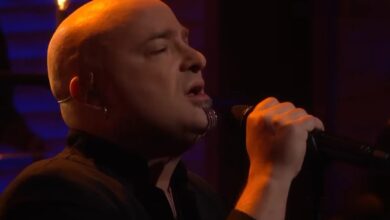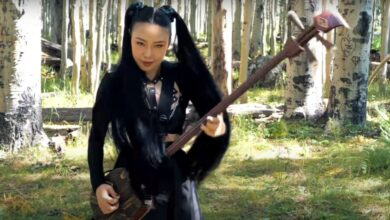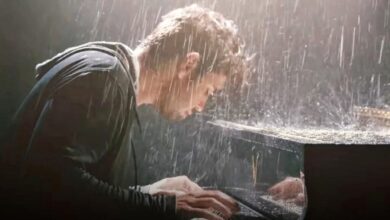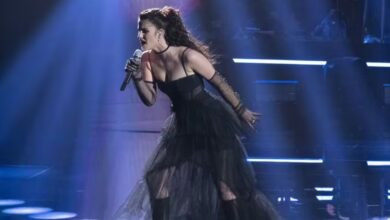A Low-Bass Reinvention of “The Sound of Silence”
Countless renditions exist of the folk-rock anthem The Sound of Silence, yet Peyton Parrish approaches the piece in a distinctive manner. Instead of revisiting the Simon and Garfunkel original, Parrish draws his inspiration from Disturbed’s celebrated version, which has amassed nearly 900 million views on YouTube. Taking on such a monumental interpretation requires a great deal of confidence, considering the devoted fanbase that holds Disturbed’s performance in such high regard.
From the very beginning, listeners notice that Parrish is intent on creating something unique rather than simply replicating what came before. While David Draiman of Disturbed begins his performance over a soft piano motif, Parrish shifts into darker territory by layering a drone beneath his vocals. His choice of a deep, gravelly low-bass delivery sets him apart from Draiman’s smoother, more operatic baritone, lending the opening verses a completely different emotional weight and texture.
As the track unfolds, the contrasts continue to emerge. Disturbed’s version reaches its dramatic peak through a sweeping orchestral crescendo, employing strings and layered arrangements for grandeur. Parrish, however, achieves a similar climax by leaning on classic rock instrumentation—guitars, percussion, and bass—giving the finale a grittier, earthier edge. One listener summed it up perfectly in the comments: “Each artist built upon the last. Simon & Garfunkel created beauty, Disturbed gave it haunting power, and Parrish pushed the energy even further. Every version has its own identity.”
Parrish’s confidence extends beyond this particular song. On 24 February 2023, he released The Most Magical Album on Earth, a collection that reimagines beloved Disney songs through his Viking rock lens. Featuring material from Frozen, Pocahontas, The Lion King, Hercules, Aladdin, and Tarzan, the album highlights his ability to take familiar material and reshape it with darker tones and a heavy, anthemic sound. One standout track is his rendition of Hoist the Colours from Pirates of the Caribbean, blending sea shanty tradition with his signature growl.
That Pirates of the Caribbean cover was uploaded just a day before the full album dropped, and in less than a year it had already climbed past one million views on YouTube. The song’s mix of theatrical intensity and rugged vocal presence demonstrates how Parrish bridges cinematic storytelling with his Viking-inspired style. It also solidifies the reputation he has built as an artist who thrives on merging mythic themes with contemporary hard rock energy.
Parrish’s personal story adds further layers to his artistry. Born in Washington, D.C. in November 1996, he moved to Los Angeles as a child before returning to Washington for college. His early musical experiments leaned toward pop-country, but in 2016, he began releasing tracks online that gradually shifted into heavier rock territory. This transformation deepened once he explored Nordic mythology, Viking imagery, and the darker resonance of his low vocal range, which has now become his trademark.
The turning point in his career came in 2020, when his rendition of My Mother Told Me from Assassin’s Creed Valhalla exploded online. Its success led to its inclusion in the popular TV series Vikings, propelling Parrish into the spotlight. That same year, he released his ambitious 29-track debut album Cowboy Man, a project that balanced country influences with Viking-inspired chants. One track, Ragnarök, went viral and today remains one of his most-watched videos, boasting nearly ten million views.
His creative momentum continued in 2022 with Rise of the Vikingr, a record steeped in Norse imagery and themes of strength, loyalty, and conquest. Combining guttural chants with heavy riffs, the album resonated with fans who had come to embrace his Viking persona. It underscored how deeply Parrish had committed to this musical direction, carving out a niche where mythological storytelling and aggressive rock meet seamlessly.
The Viking aesthetic has proven to be more than a passing experiment—it has become the defining thread of his career. Parrish’s top-performing videos all share these themes, and his collaboration with Irish artist Gavin Dunne, known as Miracle of Sound, produced Valhalla Calling, a powerful anthem inspired by Assassin’s Creed. That track has soared to over 25 million views, making it his most successful release and a cornerstone of his growing global fanbase.
Looking at his catalogue, it becomes clear that Peyton Parrish has cultivated a brand as much as a sound. He is not simply a vocalist covering familiar material; he reinterprets songs through a lens of myth, battle, and grit. This artistic identity allows him to move fluidly between Disney anthems, Viking chants, and rock classics without losing cohesion, because all are filtered through his unique voice and style. It is this consistency that has kept audiences coming back.
For fans of The Sound of Silence, the comparison between Parrish and Disturbed remains unavoidable. Yet rather than competing, the two interpretations serve as companion pieces. One harnesses operatic grandeur, the other embraces raw resonance. Both tap into the song’s haunting message while reframing it for new listeners. For many, hearing Parrish’s version after Draiman’s is not a replacement but an expansion, another lens through which to feel the song’s timeless depth.
To fully appreciate the contrasts, it helps to revisit Disturbed’s monumental version. Its orchestral sweep and Draiman’s controlled vocal fire created a benchmark for modern rock covers. By setting Parrish’s darker, bass-heavy voice alongside it, listeners can grasp how the same melody and words can conjure entirely different worlds. The dialogue between these covers ensures that Simon and Garfunkel’s masterpiece continues to evolve, inspiring audiences across generations.





